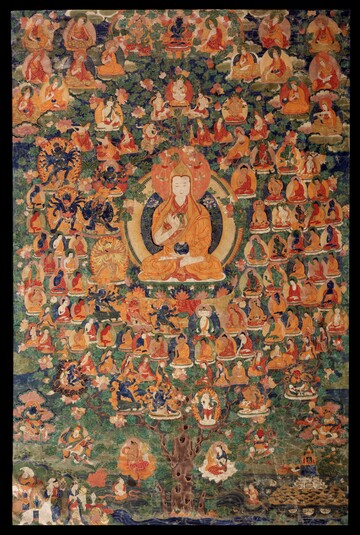
Item: Refuge Field (Buddhist) - Gelug Lineage
| Origin Location | Tibet |
|---|---|
| Date Range | 1700 - 1799 |
| Lineages | Gelug |
| Size | 101.60x67.31cm (40x26.50in) |
| Material | Ground Mineral Pigment, Fine Gold Line on Cotton |
| Collection | Rubin Museum of Art |
| Catalogue # | acc.# F1997.41.7 |
Classification: Object/Concept
Field for the Accumulation of Merit with Tsongkapa at the Center: surrounded by the Panchen Lama incarnation lineage above and with meditational deities, Confession Buddhas, arhats and protectors below - the Field for the Accumulation of Merit (Tib.: tsog shing).
This painting is created from a block print image. View the individual iconographic components of the composition. (See other examples of the same composition).
Tibetan: Tsog shing Tibetan: Lama Tsongkapa
Tibetan: Lama Tsongkapa
The multitude of religious figures is presented as if seated in a tree rising from a blue pond below at the bottom of the composition. The viewer sees it as figures arrayed on one side of a green leafy tree placed from top to bottom. This is an artistic representation. Textually it is described with Tsongkapa at the top of the tree seated on a throne and the array of figures are depicted surrounding him on a horizontal plane rather than the artistic representation of a vertical plane.
The design for this Refuge Field was created by Konchog Gyaltsen during the time of the 3rd Panchen Lama. The composition was then carved onto a broad and flat length of wood, inked, and then used to make cloth and paper wood block prints.
(The Wylie Transliteration of the inscription at the bottom of the original wood block print reads: Namo guru. blo bzang rdo rje byang gyis rnal 'byor rim/ gang gyis bris ku kon chogs brgyal mtshan lu/ zheng pa'i 'dro kun ma ... blo bzang rdo rje byang gis thob sho. See painting HAR #74089).
For more information see: Gelug Refuge Field Main Page | Refuge Field Paintings Overview | Refuge Field Components & Elements Outline
At the center of the composition is Je Tsongkapa, founder of the Gelug School of Tibetan Buddhism. He is youthful in appearance, facing forward with the right hand raised at the level of the heart in a gesture of blessing. The left hand is placed in the lap in a gesture of meditation while supporting a black begging bowl. At his heart is an image of Shakyamuni Buddha and in that heart is the primordial Buddha Vajradhara. Wearing the yellow pointed pandita hat typical of the Gelug School, along with the orange and red patchwork robes of a fully ordained Buddhist monk - Bhikshu - Tsongkapa sits in vajra posture with the right leg over the left, atop a flat white moon disc, multi-coloured lotus blossom and a golden throne. Tsongkapa sits in the middle of a giant tree surrounded by meditational deities, Buddhas, Bodhisattvas, arhats, pratyeka-buddhas, wealth deities and protectors - both beyond worldly and worldly.
At the top center is the primordial Buddha Vajradhara. On the left is Manjushri. The surrounding lamas are pre-incarnations of the Panchen Lama along with the first three official Panchen Lamas and the 8th Dalai Lama - a student of the 3rd Panchen. At the top of the tree is Vajradhara and consort accompanied by two Indian mahasiddhas, white Avalokiteshvara and another bodhisattva orange in colour. Below that is Tsongkapa as a Mahasiddha riding a tiger and Jowo Atisha dressed in the attire of a monastic figure - a large gold stupa placed at his side. Next to those are the Six Ornaments of the Southern Continent.
Descending on the left are the meditational deities Hevajra, Akshobhyavajra Guhyasamaja, Chakrasamvara and Vajrabhairava. Below that on the inside is yellow Kalachakra, Krishna Yamari, Rakta Yamari, Mahachakra Vajrapani and Maha Vairochana. Outside of those deities are the Thirty-five Confession Buddhas, bodhisattvas and arhats.
Descending on the right side are the deities red Amitayus, green Vajravidarana and white Sitatapatra, along with the Confession Buddhas, bodhisattvas and arhats.
Along the bottom of the leafy tree are the wealth deities, wisdom protector deities and worldly protector deities. In the middle slightly off center is white Sita Shadbhuja Mahakala and on the left blue Shadbhuja Mahakala, Yama Dharmaraja and Shri Devi Magzor Gyalmo. On the right side is Vaishravana and Begtse Chen.
Below the branches of the tree are yellow Brahma offering a golden wheel and on the other side of the tree trunk is a white goddess holding a golden vase. At the right and left are also the Four Guardian Kings - worldly protectors.
At the bottom left corner are the Seven Jewels of Royal Power: 1. Wheel, 2. Jewel, 3. Queen, 4. Minister, 5. Elephant, 6. Horse, and 7. General. On the right side of the composition is a miniature version of Mount Sumeru and the rings of islands along with the four continents. At the top is a small palace with the god Indra sitting inside playing a lute - stringed instrument.
Jeff Watt 11-2000 [updated 10-2010]
Publication: Worlds of Transformation
Thematic Sets
Collection of Rubin Museum of Art: Painting Gallery 3
Subject: Refuge Field Main Page
Painting Style: Men-ri (New)
Subject: Refuge Field, Gelug (Main Page)
Painting Style: Examples
Subject: Refuge Field, Gelug (Tsongkapa)
Subject: Refuge Field, Gelug (Circular & Block Print Images)
